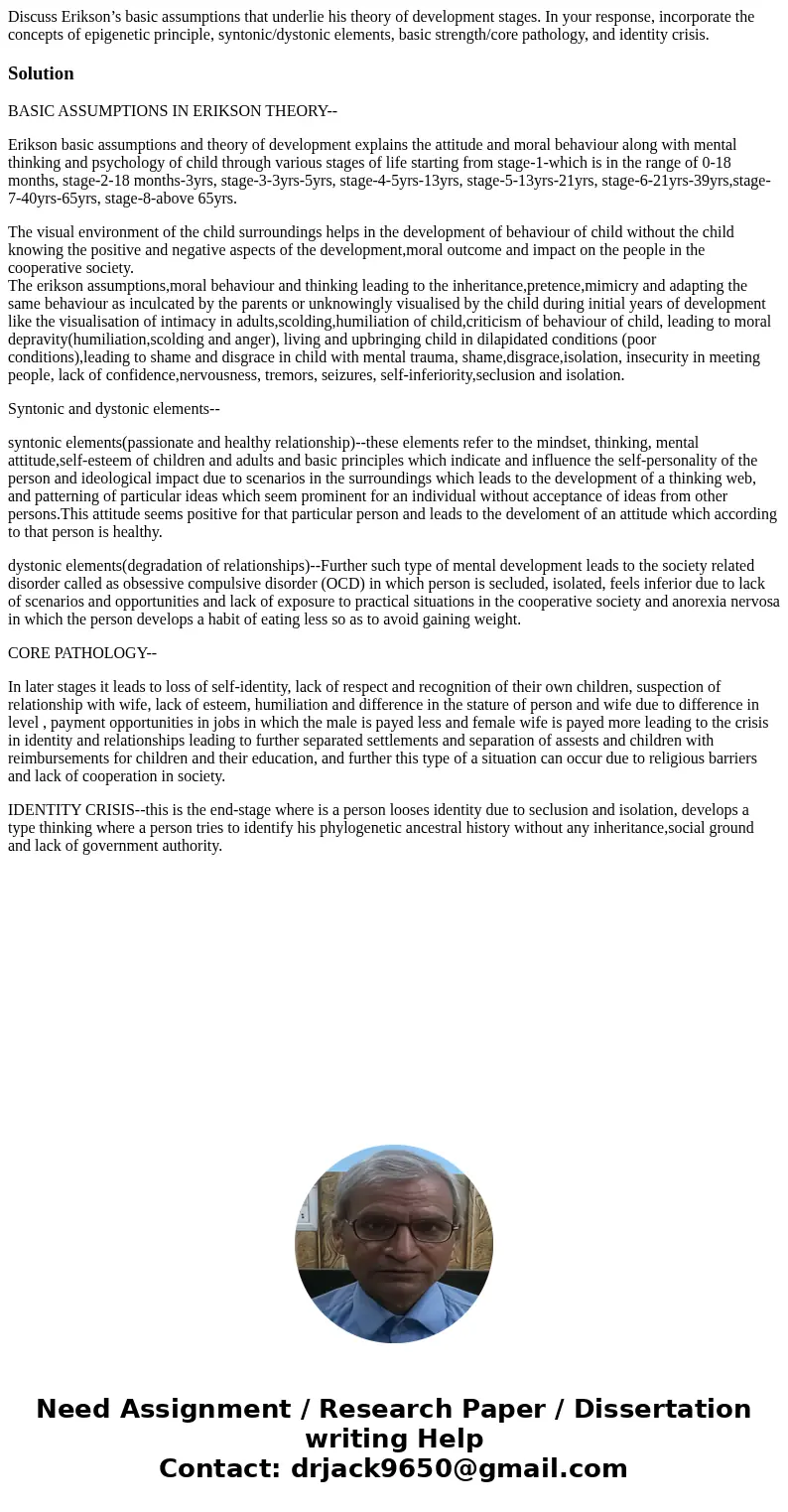Discuss Eriksons basic assumptions that underlie his theory
Discuss Erikson’s basic assumptions that underlie his theory of development stages. In your response, incorporate the concepts of epigenetic principle, syntonic/dystonic elements, basic strength/core pathology, and identity crisis.
Solution
BASIC ASSUMPTIONS IN ERIKSON THEORY--
Erikson basic assumptions and theory of development explains the attitude and moral behaviour along with mental thinking and psychology of child through various stages of life starting from stage-1-which is in the range of 0-18 months, stage-2-18 months-3yrs, stage-3-3yrs-5yrs, stage-4-5yrs-13yrs, stage-5-13yrs-21yrs, stage-6-21yrs-39yrs,stage-7-40yrs-65yrs, stage-8-above 65yrs.
The visual environment of the child surroundings helps in the development of behaviour of child without the child knowing the positive and negative aspects of the development,moral outcome and impact on the people in the cooperative society.
The erikson assumptions,moral behaviour and thinking leading to the inheritance,pretence,mimicry and adapting the same behaviour as inculcated by the parents or unknowingly visualised by the child during initial years of development like the visualisation of intimacy in adults,scolding,humiliation of child,criticism of behaviour of child, leading to moral depravity(humiliation,scolding and anger), living and upbringing child in dilapidated conditions (poor conditions),leading to shame and disgrace in child with mental trauma, shame,disgrace,isolation, insecurity in meeting people, lack of confidence,nervousness, tremors, seizures, self-inferiority,seclusion and isolation.
Syntonic and dystonic elements--
syntonic elements(passionate and healthy relationship)--these elements refer to the mindset, thinking, mental attitude,self-esteem of children and adults and basic principles which indicate and influence the self-personality of the person and ideological impact due to scenarios in the surroundings which leads to the development of a thinking web, and patterning of particular ideas which seem prominent for an individual without acceptance of ideas from other persons.This attitude seems positive for that particular person and leads to the develoment of an attitude which according to that person is healthy.
dystonic elements(degradation of relationships)--Further such type of mental development leads to the society related disorder called as obsessive compulsive disorder (OCD) in which person is secluded, isolated, feels inferior due to lack of scenarios and opportunities and lack of exposure to practical situations in the cooperative society and anorexia nervosa in which the person develops a habit of eating less so as to avoid gaining weight.
CORE PATHOLOGY--
In later stages it leads to loss of self-identity, lack of respect and recognition of their own children, suspection of relationship with wife, lack of esteem, humiliation and difference in the stature of person and wife due to difference in level , payment opportunities in jobs in which the male is payed less and female wife is payed more leading to the crisis in identity and relationships leading to further separated settlements and separation of assests and children with reimbursements for children and their education, and further this type of a situation can occur due to religious barriers and lack of cooperation in society.
IDENTITY CRISIS--this is the end-stage where is a person looses identity due to seclusion and isolation, develops a type thinking where a person tries to identify his phylogenetic ancestral history without any inheritance,social ground and lack of government authority.

 Homework Sourse
Homework Sourse